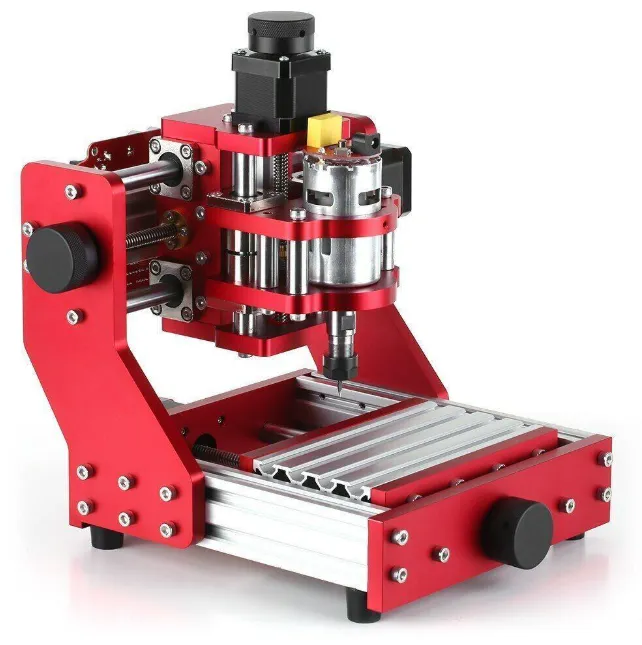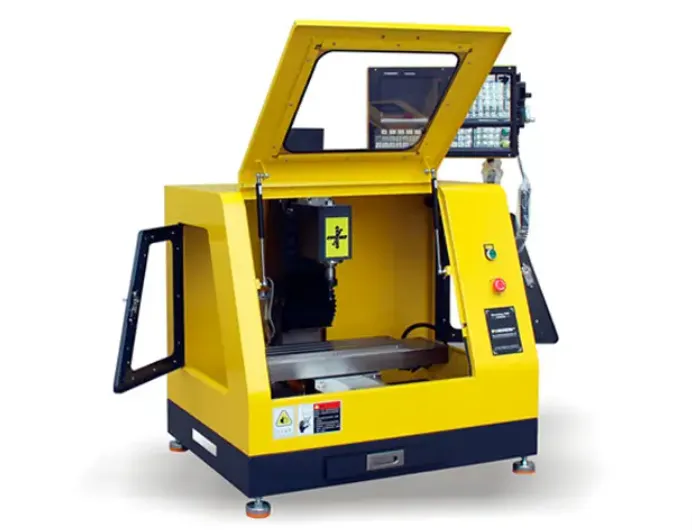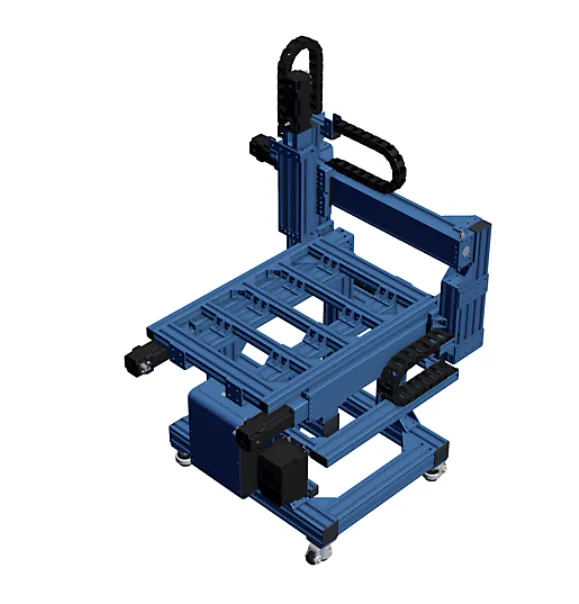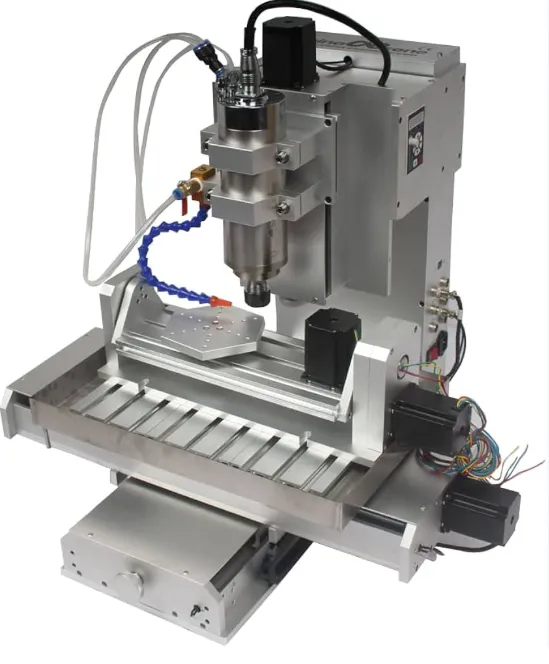Small CNC milling machines typically feature a compact yet rigid frame constructed from cast iron, polymer concrete, or high-grade aluminum to maintain stability during machining operations. The base structure incorporates precision-ground linear guideways or box-way designs that support the movement of the X, Y, and Z axes. These machines often have working envelopes ranging from 200 × 200 × 200 mm for desktop models to 600 × 400 × 300 mm for benchtop industrial units. The reduced footprint allows for installation in workshops, laboratories, and small production facilities where space is limited. Vibration-dampening materials and reinforced structural components ensure machining accuracy even during high-speed operations.
 Motion Control and Drive Systems
Motion Control and Drive Systems
The axis movement in small CNC mills is facilitated by either stepper motors or closed-loop servo systems, depending on the machine’s precision requirements. High-precision ball screws with minimal backlash (typically C5 or C7 grade) transfer motion from the motors to the machine axes, achieving positioning accuracies within ±0.01 mm. Linear encoders or rotary encoders provide real-time feedback to the control system, ensuring repeatability within ±0.005 mm. Rapid traverse speeds typically range between 10 m/min and 30 m/min, while cutting feed rates vary from 0.1 m/min to 10 m/min, depending on material and tooling. Some advanced models incorporate anti-backlash nuts and preloaded bearings to further enhance motion precision.
Spindle and Tooling Configuration
Small CNC milling machines are equipped with high-speed spindles capable of rotational speeds between 5,000 RPM and 24,000 RPM, with some models reaching up to 50,000 RPM for micromachining applications. The spindle interface commonly uses ER collet chucks (ER-11 to ER-32) or tool holders with ISO 10, ISO 20, or HSK-E25 tapers. Air-cooled spindles are standard in most small CNC mills, while liquid-cooled variants are available for prolonged high-power operations. Automatic tool changers (ATCs) with capacities of 6 to 12 tools are optional on higher-end models, reducing manual intervention and improving production efficiency. Tool length measurement systems, either touch-probe or laser-based, ensure accurate tool offset compensation.
Control System and Software Integration
The CNC control unit in small milling machines is typically based on an industrial PC running proprietary or open-source CNC software such as Mach3, LinuxCNC, or Siemens 808D. The system supports standard G-code programming and often includes conversational programming interfaces for simplified operation. USB, Ethernet, and Wi-Fi connectivity allow for seamless file transfer and remote monitoring. Some models feature integrated CAD/CAM software compatibility, enabling direct import of 3D models for toolpath generation. Real-time monitoring of spindle load, axis position, and cutting conditions ensures process stability and early fault detection.
Workholding and Material Compatibility
Small CNC mills accommodate a variety of workholding solutions, including precision vises, modular clamping systems, and vacuum tables for thin materials. T-slotted beds or machinable aluminum plates provide flexibility in fixture setups. These machines can process a wide range of materials, including:
- Metals: Aluminum, brass, mild steel, stainless steel (limited depth of cut)
- Plastics: ABS, acrylic, polycarbonate, PEEK
- Composites: Carbon fiber, GFRP, PCB materials
- Wood and Foam: For prototyping and engraving applications
Cutting parameters are adjusted based on material hardness, with aluminum typically machined at spindle speeds of 10,000–18,000 RPM and feed rates of 1–3 m/min, while plastics may require higher speeds and lower chip loads to prevent melting.
Coolant and Chip Management
Due to their compact size, small CNC mills often utilize mist coolant systems or air blast setups to minimize heat buildup and improve chip evacuation. Flood coolant systems are less common but available in some industrial-grade models. Integrated chip trays and removable collection bins simplify maintenance, while optional chip conveyors enhance continuous operation in production environments. High-speed spindles may require additional air purge systems to prevent dust and debris from contaminating the spindle bearings.
Safety and Operational Features
Safety mechanisms in small CNC milling machines include:
- Emergency stop buttons with redundant circuit breaking
- Enclosure doors with interlock switches to prevent operation when open
- Spindle overload protection and thermal monitoring
- Axis limit switches to prevent mechanical overtravel
- Ground-fault circuit interrupters (GFCIs) for electrical safety
- Transparent polycarbonate guards to contain flying chips
Operational features such as tool breakage detection, automatic workpiece probing, and adaptive feed rate control are available in advanced models to enhance machining reliability.
Applications and Industry Use Cases
Small CNC mills serve diverse industries, including:
- Prototyping and R&D: Rapid fabrication of functional prototypes
- Education: Training in CNC programming and machining
- Jewelry Making: Precision engraving and micromachining
- Aerospace and Medical: Small component manufacturing
- Electronics: PCB milling and enclosure machining
- Hobbyist and Maker Communities: Custom part production
Maintenance and Service Requirements
Routine maintenance includes:
- Daily lubrication of guide rails and ball screws
- Weekly inspection of spindle runout and belt tension (if applicable)
- Monthly cleaning of coolant systems and chip removal mechanisms
- Periodic calibration of axis alignment and backlash compensation
Future Trends and Technological Enhancements
Emerging advancements in small CNC milling technology include:
- Integration of IoT for predictive maintenance
- AI-assisted toolpath optimization
- Hybrid additive-subtractive capabilities
- Enhanced automation with robotic part loading
- Improved energy-efficient spindle designs
This detailed examination of small CNC milling machines highlights their versatility, precision, and adaptability across various applications, making them indispensable in modern small-scale manufacturing and prototyping environments.








